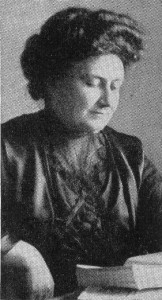Learning the Montessori Way
I have to confess that I am far from an expert on Montessori. I’m just a mom with a passion for the Montessori method. But I’ll do my best to give a little history of Maria Montessori and the Montessori method based on what I know.
Maria Montessori was born in Italy in 1870. She graduated with a medical degree from the University of Rome in 1896, which was almost unheard of for a woman of her generation. She began working with mentally disabled children, eventually becoming co-director of the Scuola Magistrale Ortofenica, a training institute for teachers working with mentally disabled children. She developed methods and materials there that she later used while working at the first Casa dei Bambini, or Children’s House, which opened in Rome in 1907.
It was from her observations of these children that she developed what would become the hallmarks of the Montessori philosophy, including using child-sized furniture that is light enough for the children to move, placing child-sized materials on easily accessible shelves, incorporating practical life activities such as flower arranging, hand washing and cooking into the curriculum, and allowing the children free choice of the materials and long periods of uninterrupted work. The success of that school led to the opening of more Children’s Houses and to an expansion of the curriculum to include reading and writing exercises.
I won’t go through the whole history of Montessori education, but suffice it to say that from these beginnings, Montessori schools continued to open throughout the world and Montessori herself continued to observe and refine her methods. For example, she recognized four distinct “planes” of human development — from birth to six years, six to 12 years, 12 to 18 years, and 18 to 24 years — and called for different educational approaches for each of these developmental phases.
Montessori also observed that there sensitive periods in which children concentrate mainly on certain activities. For example, the sensitive period for language occurs from birth to six years of age, a time in which children learn to speak, read and write. This is why it is so much easier for children to learn foreign languages at a young age.
I think it’s important to note that the name “Montessori” is not legally protected, so there are many schools out there today that aren’t truly Montessori. Anyone can use the name “Montessori,” so it’s important to check a school out and see what it’s like before you sign up your children.
In the United States, there are two main accrediting institutions — American Montessori Internationale, which was founded in 1929 by Maria Montessori and closely adheres to her original principles, and the American Montessori Society, which has modified Montessori education to more closely reflect the values of contemporary American society.
Why we incorporate Montessori principles into our home and parenting style
I’m not sure exactly how we came to embrace Montessori so completely into our life, but I know that it has worked well for us. My husband went to a Montessori preschool, but I didn’t. I have vague memories of one of my relatives going to a Montessori preschool as well when I was little, but I didn’t really know much about it. Once I found out I was pregnant, though, Montessori seemed a natural fit. I think I was influenced toward Montessori because all of our nieces have gone to Montessori schools to some extent or another, plus I have a good friend and another relative who are Montessori assistants.
As I started exploring Montessori on my own, a big influence on my thoughts was Michael Olaf. The Joyful Child became a sort of guidebook for us as to how to incorporate the Montessori method into our home. And as I read about some of Montessori’s ideas and looked at Montessori materials, I just knew it would be a good fit for us. I love beautiful things. I love order. I didn’t want my son to have a bunch of noisy, plastic electronic toys. I didn’t want to plop him in front of a television set. I wanted wood toys. I wanted to read him books.
One of the earliest Montessori materials we used in my son’s life was the Topponcino. It made transferring our son from one person to another much easier for nervous, first-time parents, and gave him a safe, snuggly place. As an infant, he also had a collection of Montessori baby toys and a Montessori-inspired mobile. Not everything we did was by the book. My son wasn’t able to breastfeed, so we used bottles and pacifiers. We used a playard occasionally to contain him, mostly when having a little one crawling or walking around would have been a safety hazard (i.e., when I was cooking). And although we never put him in a crib, he slept in an assortment of swings and a co-sleeper early on, before moving to a mattress on the floor (first with Mom (and sometimes Dad), and later (at around 8 months old) on his own).
Throughout my son’s first year of life, he had toys available to him at his level that he could choose from and the freedom to explore his world. As he entered his second year of life, we gave him real silverware and glasses and a table and chair just his size. As a two-year-old, we’re now working with him on potty training and taking care of himself (cutting his own food, taking on and off his own clothes, brushing his hair and teeth, etc.).
When I think about it, we use Montessori mostly because we’ve seen how much our son has thrived whenever we’ve done things the Montessori way, or at least as close as we could approximate. It made sense to us. It worked for us.
What role has Montessori education played in your life?





